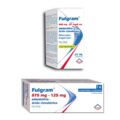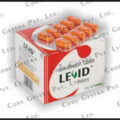Gimalxina is a Mexican brand of Amoxicillin, each capsule contains 500mg Amoxicillin (as amoxicillin trihydrate). The other ingredients are Magnesium Stearate (E572) and Colloidal Anhydrous Silica. Amoxicillin 250mg and 500mg capsule shells contain Gelatin, Carmoisine (E122), Quinoline Yellow (E104), Titanium Dioxide (E171), and Iron Oxide Yellow (E172).
Amoxicillin is used to treat a wide variety of bacterial infections. This medication is a penicillin-type antibiotic. It works by stopping the growth of bacteria. This antibiotic treats only bacterial infections. It will not work for viral infections (such as common cold, flu). Using any antibiotic when it is not needed can cause it to not work for future infections.
Amoxicillin is also used with other medications to treat stomach/intestinal ulcers caused by the bacteria H. pylori and to prevent the ulcers from returning.
How to use Gimalxina Amoxicillin 500mg
Take this medication by mouth with or without food as directed by your doctor, usually every 8 or 12 hours. The dosage is based on your medical condition and response to treatment.
Drink plenty of fluids while using this medication unless your doctor tells you otherwise.
For the best effect, take this antibiotic at evenly spaced times. To help you remember, take this medication at the same time(s) every day.
Continue to take this medication until the full prescribed amount is finished, even if symptoms disappear after a few days. Stopping the medication too early may allow bacteria to continue to grow, which may result in a return of the infection. Tell your doctor if your condition persists or worsens.
How to Spot Gimalxina Amoxicillin 500mg Fake
Antibiotics are the most counterfeited medicines and account for 28% of global counterfeit medicines . Counterfeit antibiotics are estimated at 5% of the global antibiotic market. No area in the world seems to be spared from counterfeiting of antibiotics.
However, these are rare in developed countries, whereas the strong demand for antibiotics in emerging countries creates a highly attractive market for counterfeiters. Thus, 78% of counterfeit antibiotics come from South-East Asia and their destination is mainly emerging countries (South-East Asia: 44%; sub-Saharan Africa: 30%; Europe, North America: 9%; others: 16%). Counterfeit antibiotics are antibiotics that have been commonly used for years (beta-lactams: 50%; quinolones : 12%; macrolides ,lincosamides , and synergistins: 1%; cyclins : 7%; others: 20%). The main counterfeit formulations (77%) concern oral administration(tablets, syrup, capsules) ; Counterfeit antimicrobial drugs may cause increased mortality and morbidity and pose a danger to patients.
How to recognize a counterfeit medicine
- Spot the difference. Is the lettering on the packaging hazy and printed flat (rather than raised), or is the expiry date missing?
- Read carefully. Are the labelling and patient information in a language you understand? If there are misspelled words, contact the manufacturers – it can be a telltale sign.
- Use your senses. Is the medicine the same size, shape, texture, colour and taste as your previous prescription?
- Feel for consistency. When you handle the drug does it fall apart easily? If so, it could signal a fake.
- Do a price check. Does the cost of the drug seem very cheap in comparison with your official provider? If it’s much lower, it could be a scam.
Buying medicines online
Prescriptions. Make sure the website you buy from requires a prescription and has a pharmacist you can contact for questions.
Licensing. Only buy from certified online pharmacies. Search the website for a declaration of authenticity or certification and double- check this with your country’s official drug regulatory agency. For example, pharmacies in the UK that are registered with the Royal Pharmaceutical Society of Great Britain can display a logo on their website.
Bank details. Don’t supply any credit card numbers unless you are sure the website has policies in place to protect your information and has a secure online payment system.
Promises. Statements such as ‘no risk’ and ‘money-back guarantees’ can be key giveaways of a counterfeit website.
Side Effects of Gimalxina Amoxicillin 500mg
Nausea, vomiting, or diarrhea may occur. If any of these effects persist or worsen, tell your doctor or pharmacist promptly.
Remember that your doctor has prescribed this medication because he or she has judged that the benefit to you is greater than the risk of side effects. Many people using this medication do not have serious side effects.
Use of this medication for prolonged or repeated periods may result in oral thrush or a new vaginal yeast infection (oral or vaginal fungal infection). Contact your doctor if you notice white patches in your mouth, a change in vaginal discharge or other new symptoms.
Tell your doctor right away if any of these rare but serious side effects occur: dark urine, persistent nausea or vomiting, stomach/abdominal pain, yellowing eyes or skin, easy bruising or bleeding, persistent sore throat or fever.
This medication may rarely cause a severe intestinal condition (Clostridium difficile-associated diarrhea) due to a type of resistant bacteria. This condition may occur during treatment or weeks to months after treatment has stopped. Do not use anti-diarrhea or opioid medications if you have the following symptoms because these products may make them worse. Tell your doctor right away if you develop: persistent diarrhea, abdominal or stomach pain/cramping, blood/mucus in your stool.
A very serious allergic reaction to this drug is rare. However, get medical help right away if you notice any symptoms of a serious allergic reaction, including: rash, itching/swelling (especially of the face/tongue/throat), severe dizziness, trouble breathing.
Amoxicillin can commonly cause a mild rash that is usually not serious. However, you may not be able to tell it apart from a rare rash that could be a sign of a severe allergic reaction. Therefore, get medical help right away if you develop any rash.
This is not a complete list of possible side effects. If you notice other effects not listed above, contact your doctor or pharmacist.
In the US – Call your doctor for medical advice about side effects. You may report side effects to FDA at 1-800-FDA-1088 or at www.fda.gov/medwatch
.





